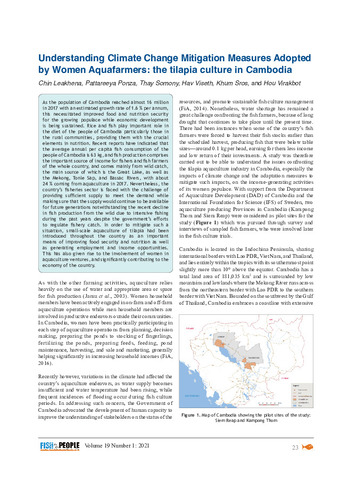Understanding climate change mitigation measures adopted by women aquafarmers: the tilapia culture in Cambodia
Share
Abstract
As the population of Cambodia reached almost 16 million in 2017 with an estimated growth rate of 1.6 % per annum, this necessitated improved food and nutrition security for the growing populace while economic development is being sustained. Rice and fish play important role in the diet of the people of Cambodia particularly those in the rural communities, providing them with the crucial elements in nutrition. Recent reports have indicated that the average annual per capita fish consumption of the people of Cambodia is 63 kg, and fish production comprises the important source of income for fishers and fish farmers of the whole country, and comes mainly from wild catch, the main source of which is the Great Lake, as well as the Mekong, Tonle Sap, and Bassac Rivers, with about 24 % coming from aquaculture in 2017. Nevertheless, the country’s fisheries sector is faced with the challenge of providing sufficient supply to meet the demand while making sure that the supply would continue to be available for future generations notwithstanding the recent decline in fish production from the wild due to intensive fishing during the past years despite the government’s efforts to regulate fishery catch. In order to mitigate such a situation, small-scale aquaculture of tilapia had been introduced throughout the country as an important means of improving food security and nutrition as well as generating employment and income opportunities. This has also given rise to the involvement of women in aquaculture ventures, and significantly contributing to the economy of the country.
Suggested Citation
Leakhena, C., Ponza, P., Somony, T., Viseth, H., Sros, K., & Virakbot, H. (2021). Understanding climate change mitigation measures adopted by women aquafarmers: the tilapia culture in Cambodia. Fish for the People , 19(1), 23-33. http://hdl.handle.net/20.500.12066/6673


